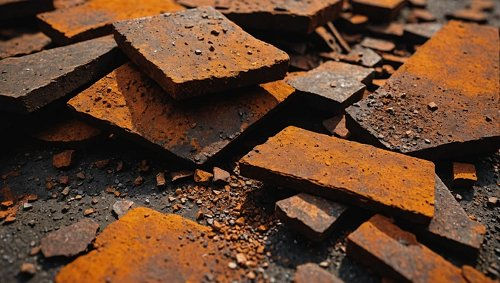Secret Life of Rust: Power of Bacteria
- Sylvia Rose

- Oct 16, 2024
- 4 min read
Rust hides within itself a secret life, orchestrated by industrious communities of microscopic bacteria with immense power in the process of corrosion. Rust bacteria carry out specialized biochemical reactions, working together to transform metals and landscapes.

Beneath the flaky surface of rusted metal is an invisible world of microbial activity. Bacteria interact, move around, attack other organisms such as amoeba, and consume their favorite foods, creating byproducts to break down metals. They're an invisible army of workers.
The bacteria crucial to the formation of rust include:
Sulfate-Reducing Bacteria (SRB)
Iron-Reducing Bacteria (IRB)
Acid-Producing Bacteria
Sulfur Oxidizing Bacteria

Sulfate-Reducing Bacteria (SRB)
Sulfate-reducing bacteria are a unique group of microbes. They thrive in low-oxygen environments. Genera such as Desulphovibrio, Desulphotomaculum, and Desulphomonas are particularly noted for their role in corrosion.
These bacteria use sulfate as a terminal electron acceptor, converting it into hydrogen sulfide during their metabolic processes. Sulfide is highly reactive, corrosive and toxic.
The production of hydrogen sulfide causes formation of sulfuric acid, known as the King of Acids, divine or royal water in alchemy, due to its potent solvent properties. This produces chemical reactions expediting the corrosion of metals.
This acid environment accelerates electro-chemical reactions giving rise to corrosion, further promoting rust formation. Also, the protective biofilm formed by these bacteria traps moisture and creates localized areas of corrosion.
Localized corrosion causes pitting and other metal degradation. SRB not only catalyze the rust process but also enhance its severity through their metabolic byproducts in extremely efficient ways.

Iron-Reducing Bacteria (IRB)
Iron-reducing bacteria are integral to the rusting phenomena. Genera such as Gallionella ferrugine and Ferrobacillus species, particularly Ferrobacillus ferrooxidans, are known for their ability to oxidize ferrous iron (Fe²⁺) to ferric iron (Fe³⁺) under anaerobic conditions.
This conversion process increases available iron and aids rust formation by creating reactive iron to interact with moisture and oxygen. Gallionella ferrugine is also interesting due to its unique morphological features, such as stalked appendages enabling it to attach to surfaces.

This attachment helps create localized conditions conducive to rust formation. Essentially, IRB form a bridge between iron metabolism and microbial respiration (the final step in decomposition), a significant contribution to the rusting process.
Fundamentally the bacteria use iron compounds as electron donors, catalyzing the reduction of iron ions and accelerating corrosion of metals.

Acid-Producing Bacteria
The role of acid-producing bacteria in rust formation is equally critical. Species from genera such as Pseudomonas, Aerobacter, and Bacillus can produce organic and inorganic acids as metabolic byproducts.
The acids lower pH of their surroundings, creating highly corrosive conditions to accelerate rust development on iron and steel surfaces. Organic acids produced by bacteria such as Pseudomonas further aid dissolution of metal oxides, thus accelerating the corrosion cycle.

The combination of acidity and moisture creates an ideal environment for the metal to corrode.
Basically these bacteria create a wave of chemical warfare on metallic surfaces. By secreting organic acids as metabolic byproducts, they lower the pH of their surroundings, advancing metal dissolution.
Sulfur Oxidizing Bacteria
Sulfur-oxidizing bacteria, particularly those in the Thiobacillus genus, are essential for the efficiency of the rusting process. These bacteria convert sulfur compounds into sulfuric acid, another agent of corrosion that can lead to rust formation.

By altering the chemical makeup of their environment, they exacerbate the effects associated with corrosive substances. They also enrich the nutrient cycle and contribute to the overall microbial ecosystem that interacts with metals in various ways.
These microbes harness the energy obtained from sulfur oxidation to fuel their metabolic processes, releasing sulfates to further fuel the corrosive cascade. Their ability to metabolize sulfur compounds makes them indispensable in the weird epic of rust formation.

Non-Fiction Books:
Fiction Books:
READ: Lora Ley Adventures - Germanic Mythology Fiction Series
READ: Reiker For Hire - Victorian Detective Murder Mysteries



